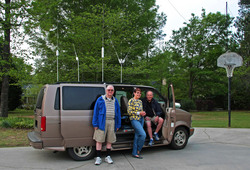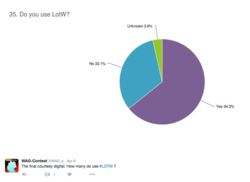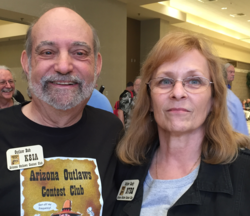 April 20, 2016 Editor: Paul Bourque, N1SFE | |||||
IN THIS ISSUE
Spring in the northern hemisphere! A good time for some antenna work. Don't forget to watch the weather and not take any chances when it comes to lightning. Next weekend has three RTTY contests. The BARTG 75 uses 75 Baud RTTY, which is almost twice as fast as the normal 45.5 Baud; depending on the software that you use for decoding, and the method, AFSK or FSK, you use for sending, getting set up for the faster speed may take a little time. See rttycontesting.com's 75 baud set up page for more information and tips to get you going. If you are using 40 meters, remember to stay clear of Ecuador earthquake relief operations around 7.060 MHz. They're using SSB, so please be extra vigilant in checking the frequency before you transmit. Parts of Ecuador continue to recover from the recent magnitude 7.8 earthquake and aftershocks. The "Cadena HC" emergency frequency is now activated and is running 24 hours per day on 7.060 MHz LSB. The HC hams have been very busy coordinating search and rescue activities on that frequency. Ecuadorean Amateur Radio operators request that the Ham Radio community keep 7.060 MHz clear for these operations. Operators, please take particular care on 40m RTTY/Digital modes to avoid the area around 7.060 MHz. (Rick, NE8Z/HC1MD via The DailyDX) If you're one of the 10,000 or so wireless professionals, university educators, or STEM students attending the IEEE IMS 2016 conference in May, why not stop by the Ham Radio Social at the San Francisco Marriott on the evening of Tuesday, May 24? Typically, more than 100 hams from around the world get together at the conference. During the conference, you can stop by the ARRL booth in the university area, where this year's theme will be encouraging industry professionals to urge students and educators to participate in Amateur Radio as a means of personal and professional development. Call for Input -- UHF and Above Contest Proposal "After receiving and reviewing considerable input from the Amateur community, the ARRL VHF Contest Revitalization Committee has drafted rules for a proposed new UHF & Up Contest and now seeks your input on this draft. In proposing the new rules, the Committee sought to respond to some of the most frequently received comments and to provide a "test bed" for changes that might be considered for other non-HF contests in the future. Among the most common themes in the comments were:
This proposal uses distance scoring with point multipliers for contacts made on higher bands. To encourage roving, it simplifies rover rules to include those who do not travel great distances and mobile stations. It includes just three entry categories and features regional rather than national competition. It adds team competition for small groups of operators who may not be part of a contest club. The timing would be in the spring, between the January and June VHF contests. Nothing is final yet, including the name of the contest. The Committee would like your input on the draft rules before the VCR Committee moves ahead with any additional changes. You may submit your comments by e-mail to mailto:vhf-input@arrl.org between now and June 15th. In addition, the Committee encourages more local outreach - articles, announcements, seminars and mentoring - to draw new participants into this and all radio sporting activities. Expanding the pool of potential contacts will make these contests more enjoyable for everyone. Please share your outreach ideas with us as well." - Kermit Carlson, W9XA, ARRL VCR Committee Chairman BUSTED QSOS Wayne Overbeck's call is actually N6NB (Dave, W6TE) The links from last issue's Operating Tip were missing, so here it is again: "TV Bob", N6TV, submits: "Ever listen to the NCDXF Beacons? The Faros program by VE3NEA can automatically listen to these beacons and record when they are heard. An excellent design ensures that even the weakest beacon signals will be detected, with QRM ignored. Here's a YouTube video of Faros in action, copying many of the 20m beacons in sequence. K2MO has posted an excellent video showing how to set up the software, which will work with virtually any transceiver." Complete information for all contests follows the Conversation section 21 Apr to 4 Mar 2016 April 21 April 22 April 23 April 24 April 27 April 28 April 29 April 30 May 1 May 2 May 3 May 4 Sponsored by DX Engineering, "The Doctor Is In" has launched a twice-monthly podcast in addition to the QST magazine column of the same name. You'll be able to listen to community-submitted technical questions answered by Joel Hallas, W1ZR, and Steve Ford, WB8IMY. The 20 minute episodes are available via iTunes, Stitcher, and Blubrry, or via "The Doctor Is In" webpage. The first episode (April 7) features HF Vertical Antennas. Sandy, DL1QQ, gave an update on the upcoming WRTC-2018 in a session during last weekend's International DX Conference in Visalia, California. For US amateurs, there are 9 qualifying events left, and the current standings can be viewed at the WRTC 2018 website. Sandy mentioned that due to solar conditions, 160 meters may be included in WRTC-2018, and pan-adapters may be allowed for the first time. Taking advantage of the rapid innovation and cheapening of communications technologies, amateur scientists are creating global sensor networks. 73 is a magic number, sometimes even outside of amateur radio. OTRSP - "Open Two Radio Switching Protocol" A specification of commands and responses involved in controlling SO2R devices. As early SO2R devices were originally controlled by manipulating PC parallel ports. Unfortunately, parallel ports are generally no longer found on PCs. OTRSP was developed to abstract the control of SO2R devices from the underlying interfaces. The YCCC SO2R box implements OTRSP. Gerald Youngblood, K5SDR, visited the Central Mississippi Amateur Radio Association (cmsara.org) in November 2015, and talked about how FlexRadio Systems was started. (Frank, K4FMH via QRP-L) When putting up wire antennas, ropes and knots are important. This video can help you learn a few new ones. (Ward, N0AX)
W0BH/m was successful in their team quest to activate 73 counties as a mobile during the Georgia QSO Party, which may be a new record for any QSO Party mobile. Bob's team included John, N6MU, Paul, N4PN, Bob, W0BH, and Lorna, K0WHY. Lorna piloted their mobile RF generator over 500 miles on each of the two days. With 3,958 contacts in the log, some operators worked them from multiple counties. Examples include K9YC and W7GKF, who found W0BH/m in 68 and 66 counties, respectively, and worked them over 100 times. DL3DXX was right in there as well, with 97 contacts over 66 counties. Check out the 3830 write-up and be on the lookout for a more extensive article in a publication in the future. Additional contest scores have been factored into the WRTC-2018 Standings. Only nine more qualifying events left for US hams!
The Worked All Germany Contest did a survey in 2015, with fifty questions ranging from LOTW use to mode preference. The results have been trickling out via Twitter: https://twitter.com/wag_e (you do not need to have a Twitter account). Hourly Rate Plan Before you enter the next contest, why not study the results from past years to inform your operating plan? Check out your results from last year, know how many contacts you made each contest hour, and on what bands. If propagation is worse this year, factor that into your potential band usage. Study the results of other stations in your area to understand what they did right, and learn from them. Sometimes actual logs are available from the contest sponsors after the contest. Occasionally, stations publish hourly rates in their 3830 summaries. Once you have your goals hour-by-hour, you can enter that information into some loggers (such as N1MM Logger+) where it will be displayed during the contest. Tom, WA9YI, sent in a link to the story of Iowa State University's research into "metaskin" that can absorb RADAR energy. "Not sure what RF applications there might be, but then we never are until we fiddle with it for awhile, right? Wrap the neighbor's grow-light operation in it to block RFI? Next best thing to a tin-foil hat?" How soon before we see an "SSB Skimmer?" Google, IBM's Watson, and other providers have real-time speech-to-text (STT) services available right now. Will someone build an application utilizing STT in time for, say, Sweepstakes? The European Space Agency used a 3D printer to fabricate a 14.5 GHz satellite antenna. After printing the part, it was coated with copper to give it its electrical properties. This might provide some ideas for methods to "print" other signal-chain items for UHF+ frequencies, for example interdigital filters. A researcher has figured out a way to do full-duplex radio using just silicon. Claiming that it subverts Lorentz Reciprocity, the CMOS circulator has potential for making higher data rates faster and cheaper. (Ward, N0AX) Technical Web Site of the Week - http://k6tu.net/?q=TerrainProfiles You've heard about terrain analyses, and you know you should probably do them to better understand your shack's location - Stu's website can step you though everything you need to do to get going with N6BV's High Frequency Terrain Analysis (HFTA) program. K6TU's website will even assist with the tedious part, the generation of the terrain profiles for your station location, by automatically pulling data from the National Elevation Dataset, or the Shuttle Radar Topography Mission database based on your latitude and longitude. Furthermore, he's built a script to automate the running of HFTA over a 360-degree sweep at your QTH, to generate antenna model files. International DX Convention & New Operators I was fortunate to be able to attend the International DX Convention in Visalia, California last weekend. Alternatively sponsored by the Northern California DX Club and the Southern California DX Club, this year was the south's turn to host. Contest-related activities over the weekend included Friday's Contest Dinner, the Topband dinner, Saturday's contest forum, sessions on rig performance, SDR, remote station operation, the NCCC hospitality suite, vendor room, hallway conversations - you get the idea. There are plenty of common interests between DXers and Contesters. The morning to wee-hours were packed. It was great to see friends in person and inspiring to see the faces associated with so many familiar calls.
The kids from the Dorothy Grant Elementary School were there, and the issue of "How do we get more youth involved?" was brought up in a few of the sessions. Are we overlooking other potential sources of new contesters? The demographic at the DX conference was primarily male, and 'mature.' What about thinking of contester spouses as potential new contesters? They already have potential access to equipment. They likely know a lot of the basics. They already hang around with contesters, or at least "a" contester. Think of the potential benefits: MORE resources devoted to the hobby you love, someone who may challenge you to be a better operator, and someone you can talk to about radio nearly any time.
Sandy, N7RQ, licensed since 1990, is a seasoned contester. I asked her how she got started in the hobby: "My brother was a ham, but never wanted to spend the time to teach me, so when I met a ham in my mid-30s, I inquired and found him a willing Elmer. Using the ARRL manuals and code tapes & devices, I went from zero (with no technical background) to a 20 WPM Extra Class in 54 weeks. The easy-to-understand way the manuals were written made the science fun for me. I received my ticket 2 weeks before the 1990 CQWW DX SSB contest, and was dumbfounded by the number of countries represented on the air during that test. I guess you could say DXing was the gateway drug to contesting for me. Understand also that to be exposed to kind, patient people from many cultures was also a huge draw for me. Above and beyond what you can do on the Internet, the opportunity to sit and talk with someone in a foreign country and learn about his or her life and family is still fascinating to me. The randomness of those contacts makes each one a treasure." Her thoughts on how to be more welcoming of spouses or YLs in general to the hobby: "I grew up in a family of boys, so I'm not intimidated by the fact that amateur radio is primarily a male hobby. For women who might feel intimidated, I'd think contesting with other women via Field Day or multi-op stations can give them the chance to learn contesting without feeling like the oddball in the group. If she's new to amateur radio and married to a ham who is also her Elmer, he might help her explore her interests: languages, cultures, DXing, science, math, antennas, propagation, and so forth, to find her place in the hobby. If she wants to improve her operating skills, contesting is certainly a great way to do that, and nothing is more fun than a 'his and hers' station. At some point, she'll find favorite contests that she wants to operate on her own, and work toward improving her scores year-over-year. That's what I did. I knew I could never beat the big guns with my modest tower and radio, but I could be a better contester." And what about her spouse, Bob, K8IA? "By the time I met my husband, Bob Epstein K8IA, I was a seasoned contester ready for the next level, and he was a well-regarded contester with a far better antenna system, and a desire to be my contest Elmer. He integrated my equipment into his existing station set-up and we've been contesting together ever since then. With friends, we started our own contest club - Arizona Outlaws Contest Club - in 2009. If women can find a contest club or group near them, they can be great resources for asking questions and learning new methods to improve scores. Best of all, they'll find themselves welcomed into a world of people who respect women contesters and their increasing contributions to the hobby." Thank you, Sandy! 73, Brian N9ADG That's all for this time. Remember to send contesting related tips, techniques, press releases, errata, selfies, pictures, stories, blog links, Twitter handles, and Field Day recipes to contest-update@arrl.org 21 Apr to 4 Mar 2016 An expanded, downloadable version of QST's Contest Corral in PDF format is available. Check the sponsor's Web site for information on operating time restrictions and other instructions. HF CONTESTS CWops Mini-CWT Test, Apr 20, 1300z to Apr 20, 1400z, Apr 20, 1900z to Apr 20, 2000z, Apr 21, 0300z to Apr 21, 0400z; CW; Bands: 160, 80, 40, 20, 15, 10m; Member: Name + Member No., non-Member: Name + (state/province/country); Logs due: April 23. VHF+ CONTESTS 432 MHz Spring Sprint, Apr 27, 1900z to Apr 27, 2300z; (not specified); Bands: 432 Only; 6-character grid square; Logs due: May 11. SBMS 2.3 GHz and Up Contest and Club Challenge, Apr 30, 0600 (local) to May 1, 2359 (local); Any; Bands: 2.3 GHz and up; 6-character Maidenhead locator; Logs due: June 1. 21 Apr to 4 Mar 2016 April 21, 2016 April 22, 2016 April 23, 2016 April 24, 2016 April 25, 2016 April 27, 2016 April 28, 2016 April 30, 2016 May 1, 2016 May 2, 2016 May 3, 2016 ARRL Information Click here to advertise in this newsletter, space subject to availability. Your One-Stop Resource for Amateur Radio News and Information ARRL membership includes QST, Amateur Radio's most popular and informative journal, delivered to your mailbox each month. Subscribe to NCJ - the National Contest Journal. Published bimonthly, features articles by top contesters, letters, hints, statistics, scores, NA Sprint and QSO Parties. Subscribe to QEX - A Forum for Communications Experimenters. Published bimonthly, features technical articles, construction projects, columns and other items of interest to radio amateurs and communications professionals. Free of charge to ARRL members: Subscribe to The ARRL Letter (weekly digest of news and information), the ARES E-Letter (monthly public service and emergency communications news), Division and Section news -- and much more! ARRL offers a wide array of products to enhance your enjoyment of Amateur Radio. Visit the site often for new publications, specials and sales. Donate to the fund of your choice -- support programs not funded by member dues! Reprint permission can be obtained by sending email to permission@arrl.org with a description of the material and the reprint publication. ACKNOWLEDGEMENTS ARRL Contest Update wishes to acknowledge information from WA7BNM's Contest Calendar and SM3CER's Contest Calendar. | |||||










